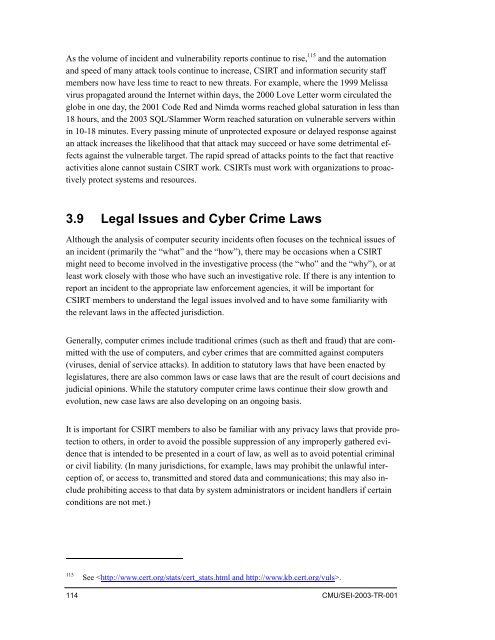State of the Practice of Computer Security Incident Response Teams ...
State of the Practice of Computer Security Incident Response Teams ...
State of the Practice of Computer Security Incident Response Teams ...
Create successful ePaper yourself
Turn your PDF publications into a flip-book with our unique Google optimized e-Paper software.
As <strong>the</strong> volume <strong>of</strong> incident and vulnerability reports continue to rise, 115 and <strong>the</strong> automation<br />
and speed <strong>of</strong> many attack tools continue to increase, CSIRT and information security staff<br />
members now have less time to react to new threats. For example, where <strong>the</strong> 1999 Melissa<br />
virus propagated around <strong>the</strong> Internet within days, <strong>the</strong> 2000 Love Letter worm circulated <strong>the</strong><br />
globe in one day, <strong>the</strong> 2001 Code Red and Nimda worms reached global saturation in less than<br />
18 hours, and <strong>the</strong> 2003 SQL/Slammer Worm reached saturation on vulnerable servers within<br />
in 10-18 minutes. Every passing minute <strong>of</strong> unprotected exposure or delayed response against<br />
an attack increases <strong>the</strong> likelihood that that attack may succeed or have some detrimental effects<br />
against <strong>the</strong> vulnerable target. The rapid spread <strong>of</strong> attacks points to <strong>the</strong> fact that reactive<br />
activities alone cannot sustain CSIRT work. CSIRTs must work with organizations to proactively<br />
protect systems and resources.<br />
3.9 Legal Issues and Cyber Crime Laws<br />
Although <strong>the</strong> analysis <strong>of</strong> computer security incidents <strong>of</strong>ten focuses on <strong>the</strong> technical issues <strong>of</strong><br />
an incident (primarily <strong>the</strong> “what” and <strong>the</strong> “how”), <strong>the</strong>re may be occasions when a CSIRT<br />
might need to become involved in <strong>the</strong> investigative process (<strong>the</strong> “who” and <strong>the</strong> “why”), or at<br />
least work closely with those who have such an investigative role. If <strong>the</strong>re is any intention to<br />
report an incident to <strong>the</strong> appropriate law enforcement agencies, it will be important for<br />
CSIRT members to understand <strong>the</strong> legal issues involved and to have some familiarity with<br />
<strong>the</strong> relevant laws in <strong>the</strong> affected jurisdiction.<br />
Generally, computer crimes include traditional crimes (such as <strong>the</strong>ft and fraud) that are committed<br />
with <strong>the</strong> use <strong>of</strong> computers, and cyber crimes that are committed against computers<br />
(viruses, denial <strong>of</strong> service attacks). In addition to statutory laws that have been enacted by<br />
legislatures, <strong>the</strong>re are also common laws or case laws that are <strong>the</strong> result <strong>of</strong> court decisions and<br />
judicial opinions. While <strong>the</strong> statutory computer crime laws continue <strong>the</strong>ir slow growth and<br />
evolution, new case laws are also developing on an ongoing basis.<br />
It is important for CSIRT members to also be familiar with any privacy laws that provide protection<br />
to o<strong>the</strong>rs, in order to avoid <strong>the</strong> possible suppression <strong>of</strong> any improperly ga<strong>the</strong>red evidence<br />
that is intended to be presented in a court <strong>of</strong> law, as well as to avoid potential criminal<br />
or civil liability. (In many jurisdictions, for example, laws may prohibit <strong>the</strong> unlawful interception<br />
<strong>of</strong>, or access to, transmitted and stored data and communications; this may also include<br />
prohibiting access to that data by system administrators or incident handlers if certain<br />
conditions are not met.)<br />
115<br />
See .<br />
114 CMU/SEI-2003-TR-001
















